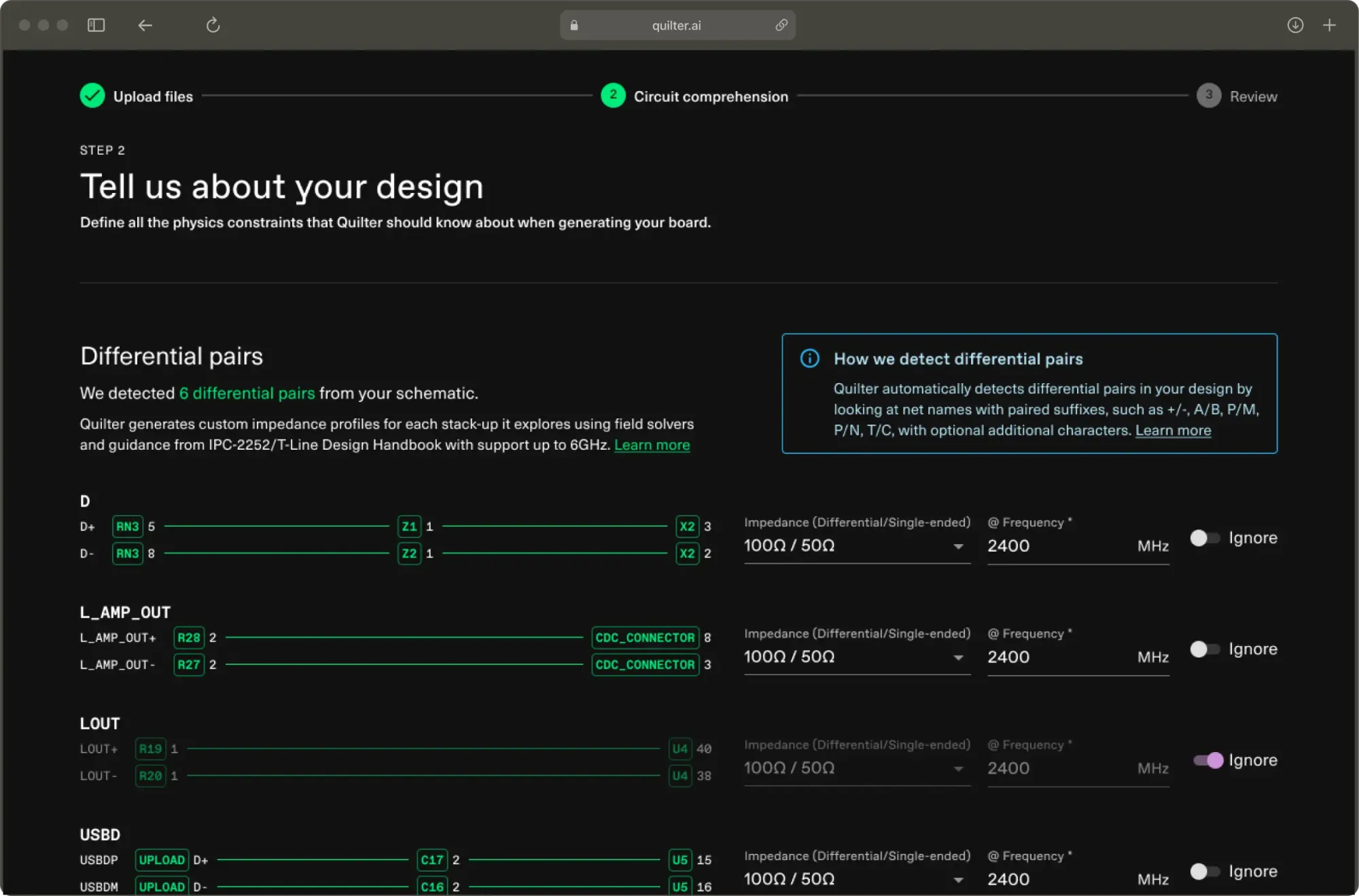Quilter can now route differential pairs!
Automatically detect differential pairs and custom-route impedance-controlled signals for each stack-up Quilter explores

We’re excited to announce that Quilter now supports differential pairs!
Differential pairs are crucial in high-speed electronics design because they help ensure adequate signal performance for digital communication protocols like USB, HDMI, and PCIe.
Getting the physics right for differential pairs typically requires designers plug information about their stack-up and board parameters into an impedance calculator or field solver to determine the appropriate trace width and spacing for routing. Whenever you add layers, introduce nearby signals, or adjust component placement, you often have to recalculate and reimplement each pair.
It's a pain in the ass and a huge time-sink in the design process.
It's also why we’re excited that Quilter can now automatically detect, calculate, and custom-route differential pairs for every candidate it explores.
Under the hood, differential pairs required three major improvements that each grow Quilter's capability as an end-to-end PCB designer:
- Quilter can now automatically detect physics considerations in your design and will soon do the same for a growing list of constraint types
- Quilter now defines and exports impedance-aware stack-ups for each design it generates, drawing from a library of dozens of fabricator-defined layer stacks.
- Quilter completes customized physics calculations for each candidate it generates to optimize and validate its designs.
Watch the following video walkthrough to see differential pairs in action, or keep reading to learn more.
1/ Automatic constraint detection
After creating a new layout job and uploading design files, you’ll see a new version of our Constraints page titled “Circuit Comprehension.”
The purpose of Circuit Comprehension is to establish a complete understanding of the essential physics considerations that must be represented in your PCB design. You can think of each constraint as a “unit test” that should be satisfied by each layout that Quilter generates.
Instead of manually defining differential pair constraints, Quilter now automatically detects them in your input files, which you can then review and approve.
Here’s what it looks like:

You can specify each pair's differential impedance and carrier frequency so that Quilter can complete the calculations required to customize each differential pair for every stack-up it explores.
Speaking of stack-ups…
2/ Fabricator-standardized stack-ups
Previous designs that Quilter generated were “fabricator agnostic”; you could build them with any PCB manufacturer because the design didn’t strongly depend on the stack-up's material properties.
With the introduction of impedance-controlled signals, Quilter now provisions each layout candidate using a standard 2, 4, or 6-layer stack-up from one of our preferred fabrication partners.
Quilter’s design library consists of dozens of predefined stack-ups from top fabricators like OSH Park, JLCPCB, and MacroFab, along with corresponding design rules for each stack-up. The specific fabricator and stack-up profile used to generate each layout are identified in the candidate details pane at the bottom of the candidate viewer.

If you want to look only at designs that use particular stack-ups from a specific manufacturer, you can filter your candidates by fabricator, layer count, or design rules.

Upon download, all the stack–up details—including layer thickness, layer type, dielectric constant, and dissipation factor—are exported along with the board file.
Excited to use Quilter with your own stack-ups? Quilter will soon support uploading custom stack-ups by defining them in your ECAD input files. Until then, just let us know if there’s a stack-up you’d like to see us add to Quilter.
3/ Physics calculations and routing for impedance-controlled signals
Quilter handles the impedance control calculations, so you don’t have to. Quilter calculates differential pair trace widths and spacings to meet target impedance requirements using a 2D quasi-static field solver that considers each candidate’s unique stack-up.
These are translated into impedance profiles tailored to each stack-up, routing layer, and transmission line type.

Quilter can't handle all differential pair types at launch and will have some initial limitations we're excited to lift as soon as possible. To start, impedance profiles are currently limited to 85Ω and 100Ω differential impedance.
If you want to try differential pairs on your design, head to the Quilter app and upload a board with nets labeled with paired suffixes using one of our supported identifiers.


